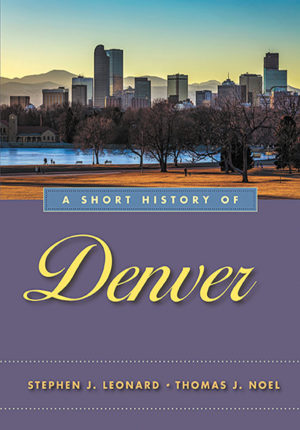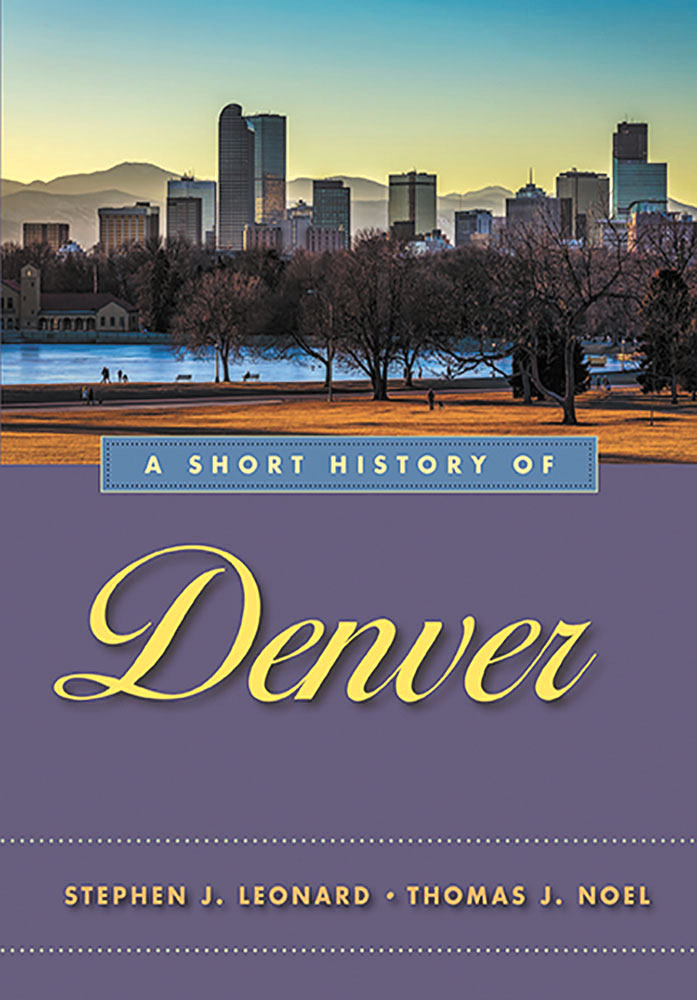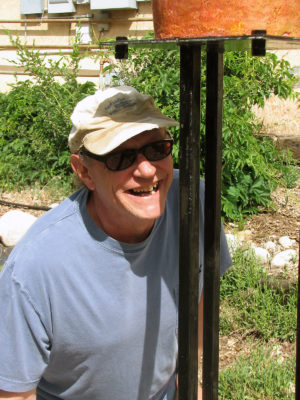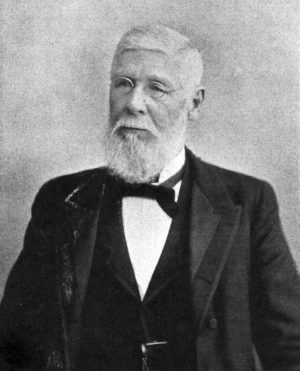 Stephen J. Leonard, Thomas J. Noel
Stephen J. Leonard, Thomas J. Noel
University of Nevada Press, paper, 212 pp, $21.95
Reviewed by Annie Dawid
History and “short” don’t usually go well together, but in this case, the celebrated Denver Post columnist Thomas J. Noel and his co-writer, Stephen J. Leonard, history professor at the University of Colorado-Denver, make the combination fascinating, funny and relevant.
Both writers point out that much history – often written by the victors – shows only the positive, the city bountiful, in this case, leaving out the lives of the poor, the disaffected, the victims. “Until the 1970s, most local historians lauded the city’s rich … failing to see that it was often a coarse, brutal place.”
The brutality begins, as one would expect, with the treatment of the Native Americans, who once called this part of the world their home. Around 1800, the Cheyenne and Arapahoe begin hunting and camping around the site in Colorado that would eventually become the capital of the state. In 1851, the Treaty of Fort Laramie is signed with several Northern Plains tribes, giving them ownership of the land. This treaty is one of many which will shortly become worthless. The Sand Creek massacre occurs a mere thirteen years later, in which white soldiers kill 163 Cheyenne and Arapahoe, mostly women and children, all weaponless.
For readers already initiated in the history of Denver, this short volume will likely contain much familiar information. But the authors go beyond the ordinary, the banal and the expected to find the stories left out by those historians seeking to create pretty pictures only. We learn of the rise of the Ku Klux Klan in the 1920s and its broad appeal, which included Mayor Stapleton among its adherents. “To save his political hide, Stapleton openly embraced the Klan, and the organization helped him survive the recall” of 1924, organized by anti-Klan activists. A black and white photo of a Klan parade down 16th Street chills the viewer, as the white-hooded men fill the frame as far as the eye can see. That year, the Klan also helped elect a governor, Clarence Moreley, himself a Klansman. The group gained many political perks in addition to terrorizing Blacks, Jews and Catholics. However, “the magnitude of its triumph was matched by the speed of its downfall.” When Klan members were exposed as not upholding Christian values, and the Grand Dragon of Denver was charged with tax evasion, the group rapidly lost its political pull.
But prejudice did not need the Klan to prosper. Real estate covenants could legally ban Blacks and Jews from most neighborhoods until the 1940s. When Blacks tried to swim with whites at Washington Park in 1932, they were driven out by a mob. Twenty years later, an African-American reporter for the Denver Post tried to swim at a Lakeside pool, where the manager warned him that other swimmers might throw rocks. When the reporter visited Crestview Trailer Camp on Federal Boulevard, he was told, “We don’t have restrictions on pets, but we have to draw the line on Negroes.”
Blacks were not the sole victims of angry whites. In 1880, a Chinese laundry worker was beaten to death. Two Jewish men were beaten for working on Christmas Day in 1905, and one of them would die of his injuries. Due to the attendance of Catholic schools by many Hispanic and Irish citizens, the public schools managed to stay fairly white. When busing was ordered in the 1970s by a Supreme Court decision, someone dynamited 38 public school buses, destroying 23 of them.
In its short history, Denver does achieve some hard-fought gains. Federico Peña is elected the first Latino mayor in 1983, followed by the first African-American mayor, Wellington Webb, in 1991. Colorado sent its first woman to Congress in 1972 in the person of Patricia Scott Schroeder. And by 2014, both Denver and Aurora’s city councils had more women than men.
In the arena of conservation, the Denver area managed to preserve some open space with the purchase of Greenland Ranch in 2000 near Larkspur, preventing the I-25 corridor from becoming wall-to-wall suburbia. Many of the smaller cities in the Denver area promoted parks, playgrounds and athletic fields, keeping their percentage of non-developed spaces at a higher proportion than cities nationwide. Boulder, originally called Deadwood Diggings, now the state’s 11th biggest city, has led Colorado in its construction of greenbelts and the limiting of building permits.
For anyone who wants to dig beneath the platitudes of Denver’s founding and various rises – and falls – this book will serve as the first shovel. The authors helpfully include an extensive bibliography for those wanting to excavate further.



